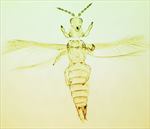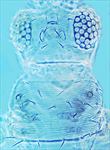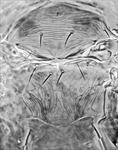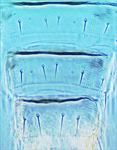
Female

Head & pronotum

Mesonotum & metanotum

Abdominal tergites

Tergites VI–VIII

Male, drepanae on tergite IX

Fore wing
Both sexes fully winged. Body mainly yellow, antecostal ridges of tergites and sternites light brown, tergites III–VII with paired shaded areas anterolaterally; antennal segment I white, II - VIII light brown; major setae light brown; fore wings weakly shaded, clavus dark. Antennae 8-segmented; segments III & IV each with stout forked sense cone. Head wider than long; ocellar region with weak and widely spaced lines, postocular region with closely spaced sculpture lines; 3 pairs of ocellar setae present, pair III within ocellar triangle behind fore ocellus. Pronotum with closely spaced sculpture lines; posterior margin with 4 pairs of setae, S2 about 30 microns long. Metanotum with lines of sculpture parallel medially but diverging near posterior margin; median setae well back from anterior margin; campaniform sensilla absent. Fore wing first vein with 3–4 setae on distal half, second vein with 3 widely spaced setae; posteromarginal cilia wavy. Abdominal tergites III–VI with median setae small but close together; II–VIII with lateral thirds covered in closely spaced rows of fine microtrichia, these microtrichial fields with 3 discal setae, posterior margins with comb; tergite VIII with comb complete, with discal microtrichia medially; tergite IX without discal microtrichia. Sternites without discal setae; rows of microtrichia present laterally, but not extending mesad of setae S2; posterior margins without comb of microtrichia.
Male smaller than female; tergite IX posterior angles with pair of stout dark drepanae extending around segment X; sternites without pore plates.
S. perseae differs from the common Californian species, S. citri, in having dark markings on the body, and in having prominent dark drepanae at the apex of the abdomen in males. Bailey (1964) provided keys to 13 from North America, but that work was based on specimens that were not fully cleared, and thus few structural details were available concerning differences between species. Similarly, Johansen & Mojica-Guzman (1999) provided keys to 37 species from Mexico, but Hoddle et al. (2008) recognised five of these as synonyms of S. perseae, and Mound & Hoddle (2016) placed a further 15 as synonyms of S. citri. Hoddle & Mound (2003) provided information on 21 Scirtothrips species from Australia, and Rugman-Jones et al. (2006) produced a molecular key to several pest species in this genus. Scirtothrips currently comprises 100 listed species from various parts of the world.
Breeding on young tissues of leaves and fruits of Persea americana [Lauraceae](Hoddle, 2002). This can cause severe surface damage to avocado fruit.
Presumably originally from Mexico and Guatemala, this species has been introduced to California and more recently to Hawaii.
THRIPIDAE - THRIPINAE
Scirtothrips perseae Nakahara
Scirtothrips perseae Nakahara, 1997: 189
Scirtothrips aguacatae Johansen & Mojica-Guzmán, 1998: 34
Scirtothrips kupandae Johansen & Mojica-Guzmán, 1998: 47
Scirtothrips manihotifloris Johansen & Mojica-Guzmán, 1998: 55
Scirtothrips tacambarensis Johansen & Mojica-Guzmán, 1998: 62
Scirtothrips uruapaniensis Johansen & Mojica-Guzmán, 1998: 66.
Bailey SF (1964) A revision of the genus Scirtothrips Shull (Thysanoptera: Thripidae). Hilgardia 35: 329–362.
Johansen RM, Mojica-Guzman A (1999) The genus Scirtothrips Shull, 1909 (Thysanoptera: Thripidae, Sericothripini), in Mexico. Folia Entomologica Mexicana 104: 23–108.
Hoddle MS, Mound LA, Rugman-Jones PF & Stouthamer R (2008) Synonomy of five Scirtothrips species (Thysanoptera: Thripidae) described from Avocados (Persea americana) in Mexico. Florida Entomologist 91: 16–21.
Mound L & Hoddle M (2016) Scirtothrips species (Thysanoptera, Thripidae) described from mango, Mangifera indica, in Mexico. Florida Entomologist 99 (4):759–764.
Rugman Jones PF, Hoddle MS, Mound LA, & Stouthamer R (2006) Molecular identification key for pest species of Scirtothrips (Thysanoptera: Thripidae). Journal of Economic Entomology 99: 1813–1819.